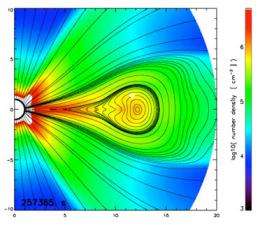Scientists Use Atomic Physics Codes to Study Coronal Mass Ejections

(PhysOrg.com) -- Giant eruptions of ionized gas, or plasma, from the Sun called coronal mass ejections [CMEs] produce solar energetic particles that cause spacecraft anomalies and communication interruptions, and can have significant adverse effects on Global Positioning Systems. Scientists at the Naval Research Laboratory's Space Science Division are studying CMEs in an effort to better understand and predict their impact on instrumentation.
The composition of CMEs can tell us much about how they erupt and propagate through interplanetary space. The NRL research team is now coupling computer codes that compute the evolution of CME ion charge states (elements such as Carbon or Iron with different numbers of electrons removed) to the output of numerical magnetohydrodynamic simulations of CME dynamics.
The ionization evolution code used in the simulations, developed by Martin Laming and Cara Rakowski of the Space Science Division, incorporates the latest and most accurate theoretical data for ionization and recombination (removal and attaching electrons to an element) of all ions up to Nickel in the periodic table.
Of the abundant elements in the solar atmosphere, Iron [Fe] is highly useful to study, because it has many charge states to evolve through. As a simulated CME eruption proceeds, plasma heating beginning at a heliocentric distance of about four solar radii increases the charge states of the ions in the plasma.

The final simulated Fe charge state distribution exhibits a characteristic "two-peaked" structure that is commonly detected in CME observational data for Fe, with charge states around Fe16+ and Fe11+ dominant, which indicates that basic features of the new coupled numerical model are correct.
Laming explains that a research goal of this work is to produce quantitative inferences about the energy released, and estimate for example the energy going into solar energetic particles that constitute a major radiation hazard for space borne instrumentation. Such inferences are only feasible because the energy required to produce specific ions is understood from atomic physics.
Provided by Naval Research Laboratory


















